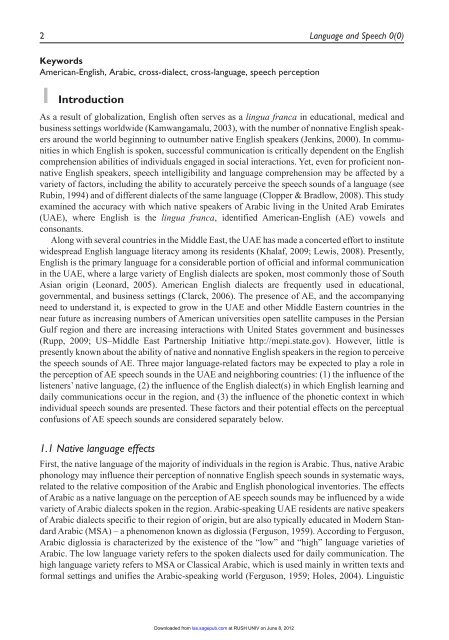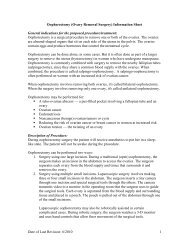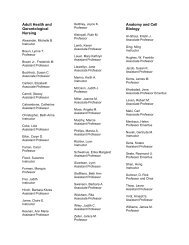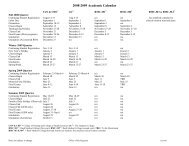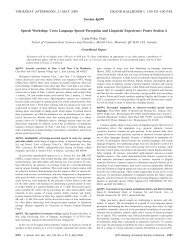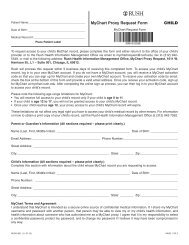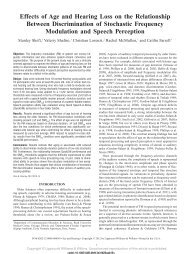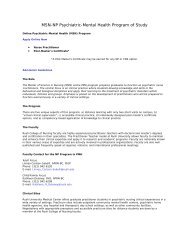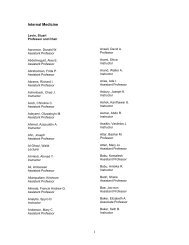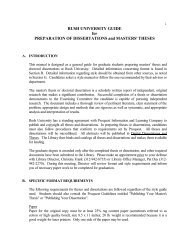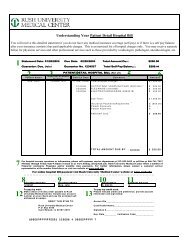English Vowels and Consonants by Native Arabic ... - Rush University
English Vowels and Consonants by Native Arabic ... - Rush University
English Vowels and Consonants by Native Arabic ... - Rush University
Create successful ePaper yourself
Turn your PDF publications into a flip-book with our unique Google optimized e-Paper software.
2 Language <strong>and</strong> Speech 0(0)KeywordsAmerican-<strong>English</strong>, <strong>Arabic</strong>, cross-dialect, cross-language, speech perception1 IntroductionAs a result of globalization, <strong>English</strong> often serves as a lingua franca in educational, medical <strong>and</strong>business settings worldwide (Kamwangamalu, 2003), with the number of nonnative <strong>English</strong> speakersaround the world beginning to outnumber native <strong>English</strong> speakers (Jenkins, 2000). In communitiesin which <strong>English</strong> is spoken, successful communication is critically dependent on the <strong>English</strong>comprehension abilities of individuals engaged in social interactions. Yet, even for proficient nonnative<strong>English</strong> speakers, speech intelligibility <strong>and</strong> language comprehension may be affected <strong>by</strong> avariety of factors, including the ability to accurately perceive the speech sounds of a language (seeRubin, 1994) <strong>and</strong> of different dialects of the same language (Clopper & Bradlow, 2008). This studyexamined the accuracy with which native speakers of <strong>Arabic</strong> living in the United Arab Emirates(UAE), where <strong>English</strong> is the lingua franca, identified American-<strong>English</strong> (AE) vowels <strong>and</strong>consonants.Along with several countries in the Middle East, the UAE has made a concerted effort to institutewidespread <strong>English</strong> language literacy among its residents (Khalaf, 2009; Lewis, 2008). Presently,<strong>English</strong> is the primary language for a considerable portion of official <strong>and</strong> informal communicationin the UAE, where a large variety of <strong>English</strong> dialects are spoken, most commonly those of SouthAsian origin (Leonard, 2005). American <strong>English</strong> dialects are frequently used in educational,governmental, <strong>and</strong> business settings (Clarck, 2006). The presence of AE, <strong>and</strong> the accompanyingneed to underst<strong>and</strong> it, is expected to grow in the UAE <strong>and</strong> other Middle Eastern countries in thenear future as increasing numbers of American universities open satellite campuses in the PersianGulf region <strong>and</strong> there are increasing interactions with United States government <strong>and</strong> businesses(Rupp, 2009; US–Middle East Partnership Initiative http://mepi.state.gov). However, little ispresently known about the ability of native <strong>and</strong> nonnative <strong>English</strong> speakers in the region to perceivethe speech sounds of AE. Three major language-related factors may be expected to play a role inthe perception of AE speech sounds in the UAE <strong>and</strong> neighboring countries: (1) the influence of thelisteners’ native language, (2) the influence of the <strong>English</strong> dialect(s) in which <strong>English</strong> learning <strong>and</strong>daily communications occur in the region, <strong>and</strong> (3) the influence of the phonetic context in whichindividual speech sounds are presented. These factors <strong>and</strong> their potential effects on the perceptualconfusions of AE speech sounds are considered separately below.1.1 <strong>Native</strong> language effectsFirst, the native language of the majority of individuals in the region is <strong>Arabic</strong>. Thus, native <strong>Arabic</strong>phonology may influence their perception of nonnative <strong>English</strong> speech sounds in systematic ways,related to the relative composition of the <strong>Arabic</strong> <strong>and</strong> <strong>English</strong> phonological inventories. The effectsof <strong>Arabic</strong> as a native language on the perception of AE speech sounds may be influenced <strong>by</strong> a widevariety of <strong>Arabic</strong> dialects spoken in the region. <strong>Arabic</strong>-speaking UAE residents are native speakersof <strong>Arabic</strong> dialects specific to their region of origin, but are also typically educated in Modern St<strong>and</strong>ard<strong>Arabic</strong> (MSA) – a phenomenon known as diglossia (Ferguson, 1959). According to Ferguson,<strong>Arabic</strong> diglossia is characterized <strong>by</strong> the existence of the “low” <strong>and</strong> “high” language varieties of<strong>Arabic</strong>. The low language variety refers to the spoken dialects used for daily communication. Thehigh language variety refers to MSA or Classical <strong>Arabic</strong>, which is used mainly in written texts <strong>and</strong>formal settings <strong>and</strong> unifies the <strong>Arabic</strong>-speaking world (Ferguson, 1959; Holes, 2004). LinguisticDownloaded from las.sagepub.com at RUSH UNIV on June 8, 2012


